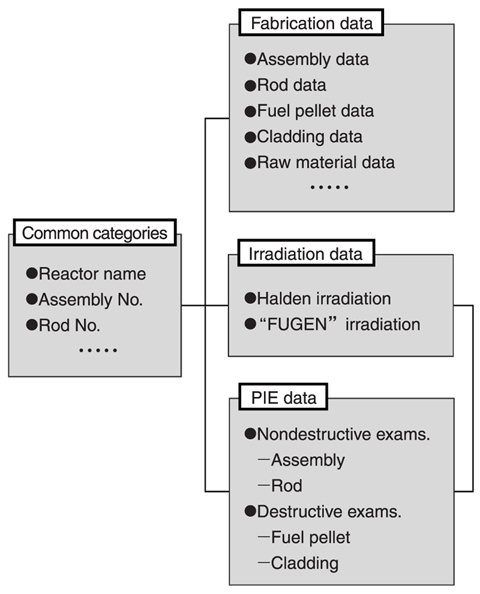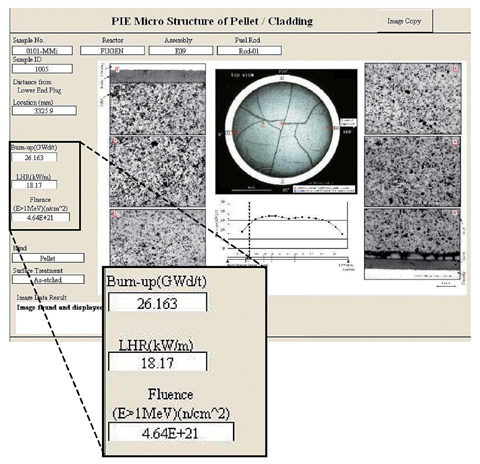
Fig.14-8 Outline of MOX fuel database

Fig.14-9 Display image of PIE data
For the effective utilization of energy resources, preparations are underway to recycle plutonium separated by reprocessing the spent fuels from nuclear power plants into nuclear fuels for Light Water Reactors (LWRs). In this nuclear fuel cycle, plutonium is reused as mixed uranium-plutonium oxide (MOX). In Japan, a total of 772 MOX fuel assemblies were used in "FUGEN" without any failure until the end of its operation in March, 2003, the most MOX fuel usage by a thermal reactor in the world.
We developed a MOX fuel database (Fig.14-8) to make the most of our experiences with "FUGEN" in helping improve the reliability of future MOX fuel use in LWRs. This database includes the data from not only MOX fuel assemblies irradiated in "FUGEN" but also Norway's "Halden" reactor test data of MOX fuel assemblies whose fuel center temperature, cladding elongation, rod inner pressure etc. during irradiation were measured by in-pile instruments (Fig.14-9). The post-irradiation examinations necessary to evaluate MOX fuel performance were carried out on the MOX fuel assemblies irradiated in "FUGEN", whose Pu content was ~6wt.% and whose pellet peak burn-up reached ~50GWd/t. Consequently, we were able to obtain data helpful in evaluating the irradiation behavior of MOX fuels. In the regular operation irradiation tests in "Halden", the pellet peak burn-up of MOX fuel rods reached ~60GWd/t, and MOX fuel rods used for the power ramp test in "Halden" were irradiated to the maximum linear power (~70kW/m), which was ~10kW/m higher than that of UO2 fuel rods, without failure. In addition, as the result of the load-follow test in "Halden", we confirmed that the power changes due to load following during reactor operation had no influence on the integrity of MOX fuel rods.
In the MOX fuel database development, we systematically arranged fabrication, irradiation, and post-irradiation examination data which were obtained from several irradiation tests performed in "FUGEN" and "Halden", and organized irradiation data such as power output history to facilitate input of data for fuel behavior evaluation with computation codes.
These MOX fuel data are also included in the IFPE (International Fuel Performance Experiments) database in OECD/NEA, and are appreciated throughout the world. In Japan as well, we expect this data to contribute to improving the reliability of MOX fuel use in LWR in the future.